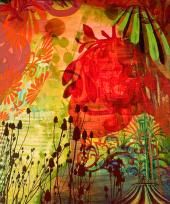 (Editor's note: St. Ambrose University art professor Kristin Quinn opened a sabbatical exhibit - Between Sea & Sky - last week in the school's Catich Gallery. River Cities' Reader art critics Bruce Carter and Steve Banks met to talk about her new work. Excerpts of their conversation follow; audio from their discussion can be downloaded by clicking here .)
(Editor's note: St. Ambrose University art professor Kristin Quinn opened a sabbatical exhibit - Between Sea & Sky - last week in the school's Catich Gallery. River Cities' Reader art critics Bruce Carter and Steve Banks met to talk about her new work. Excerpts of their conversation follow; audio from their discussion can be downloaded by clicking here .)
Bruce Carter: "Kristin is a wonderful colorist. She's been working large for the last several years. She's been using a lot of these stencils, forms of plants and almost kind of balustrades, ironworks across it, and she's been superimposing that on her pictures, overlapping.
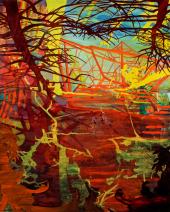 "It seems that this show of seven pieces is becoming more natural, that she's using these branches and trees - thick, and almost Southern swampy trees, by a pool of water - as a stencil form."
"It seems that this show of seven pieces is becoming more natural, that she's using these branches and trees - thick, and almost Southern swampy trees, by a pool of water - as a stencil form."
Steve Banks: "To me the stencils act like fences - a denial. Even the flowers, which are kind of welcoming, prevent me from going into those spaces. It's an intentional denial to me. The thing that I'm seeing with the work here that I haven't seen as much before is more access to the interior space."
Carter: "I would like to see what's going to happen when these black stencils - which are interesting and nice - disappear."
Banks: "I come from more of a high-contrast, photo, graphic-design, silk-screening background, so these really appeal to me. That's a flatness that I have a lot in my pieces, and the battle between the two I find very compelling.
"She knows there's good stuff back there, and it's hers."
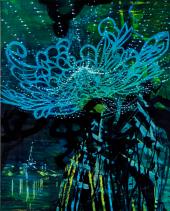 Carter: "Something hidden, and something seen. Things are being revealed and yet also hidden."
Carter: "Something hidden, and something seen. Things are being revealed and yet also hidden."
Banks: "It's tantalizing and it taunts you, but you're not allowed more access to it.
"The colors make you want to dive in, and the flatness up on the surface is holding you back at the same time. It would be kind of like if I were to grab your collar to pull you toward me but also hold you back by having a hand on your forehead.
"There is a confrontation between the bright colors and the darker shapes. I don't think it's mean-spirited, but it's just a tension she sets up in the work that when you look at them you're forced to experience. You can't circumnavigate the fact that that tree prevents you from going in deeper, but the colors make you want to go in deeper."
Carter: "These pieces for me seem to be getting not denser, but thicker in space.
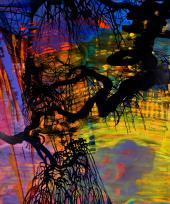 "You can see layers going back, but she's really getting a sense of space going back, that real depth of space and perspective. Her colors are just gorgeous. She's one of the very best colorists I've ever seen.
"You can see layers going back, but she's really getting a sense of space going back, that real depth of space and perspective. Her colors are just gorgeous. She's one of the very best colorists I've ever seen.
"It seems to be kind of a transition. Before they were completely abstract, but now she seems to be getting a little more referential. But I don't know what she's referring to. An artist would refer to experience - what else are you going to talk about? - or maybe other art. I don't really see quotes of other artists in here.
"She's got plays of opposites going on all the time - static and moving, confrontational and nonconfrontational, thin and thick, flat space and space going back. I'm still trying to figure out the take-home. What is she saying?"
Banks: "There's not necessarily a specific identifiable story, but it seems to me like something taken from a story - it's just a quick flash or an innuendo or a fleeting wisp of it there. It's just to give the slightest shock of some experience."
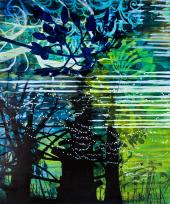 Carter: "There seems to be a certain amount of despair in this, that all these structures and ships look like they've been lost, or abandoned."
Carter: "There seems to be a certain amount of despair in this, that all these structures and ships look like they've been lost, or abandoned."
Banks: "There's almost a post-apocalyptic kind of thing. Nature keeps going on. So you've got these human elements that are in here, almost as an aside or a backdrop. It's clearly devolved from where things once used to be.
"There aren't people here. There's evidence that people had been there."
Carter: "Where people have been or people have seen or people have constructed at some point. Almost like looking back at history.
"What I'm getting through here is the dominance of these natural tree branches, these gnarls and knots of things, which are supreme in the picture. Mankind is there, but it's being overwhelmed. And so it's the nature that is not going away. And yet the nature is a bit macabre."
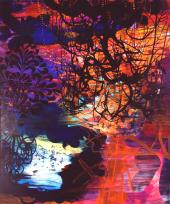 Banks: "It impresses me, the number of really funky, ugly colors in here that when put together start kicking major ass and become really cool. You've taken two wrongs and more than made it right - you've made it awesome. If I were to paint your house that color, you'd come find me, and not to pay me.
Banks: "It impresses me, the number of really funky, ugly colors in here that when put together start kicking major ass and become really cool. You've taken two wrongs and more than made it right - you've made it awesome. If I were to paint your house that color, you'd come find me, and not to pay me.
"If those two colors covered the entire surface, they would sink the painting. You've got maybe 70 to 80 percent of the surface of this is more muted colors; when you look at it, there are just a few places that have that energized color. If you did a battle between three obnoxious colors and that was it, that would be very garish. These aren't garish; they're quite eloquent."
Carter: "I like her work very much. I don't know if I would want to have it in my house, because of the expanse of darks and blacks. It would seem to overpower any room."
Banks: "I'll take one."
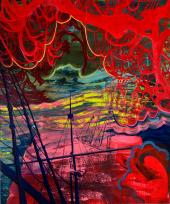 Kristin Quinn's Between Sea & Sky runs through March 21 at the Catich Gallery inside of St. Ambrose University's Galvin Fine Arts Center.
Kristin Quinn's Between Sea & Sky runs through March 21 at the Catich Gallery inside of St. Ambrose University's Galvin Fine Arts Center.
An opening reception will be held from 5 to 7 p.m. on Friday, February 29.
To download the Reader's discussion of Quinn's exhibit, click here.










